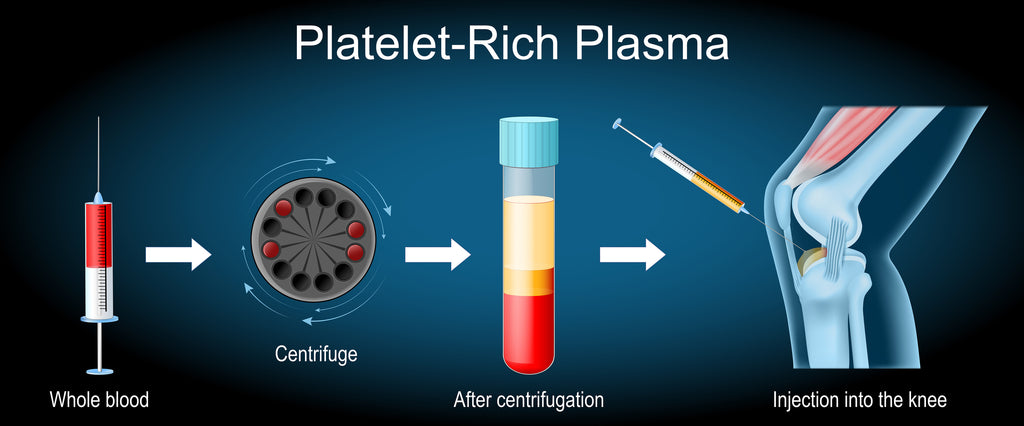Platelet-Rich Plasma Therapy (PRP)

What is Platelet-Rich Plasma Therapy (PRP) used for?
PRP (Platelet-Rich Plasma) therapy is a regenerative treatment that utilizes a patient's own blood to promote healing and tissue repair. It is commonly used for the following purposes:
Orthopedic Conditions
Treating chronic tendon injuries like tennis elbow or Achilles tendinitis
Accelerating healing of acute muscle, ligament, or tendon injuries and tears
Managing mild to moderate osteoarthritis, particularly in the knees
Sports Injuries
PRP therapy is popular among athletes as it can help speed up recovery from various sports-related injuries, such as sprains, strains, and overuse injuries.
Hair Loss Treatment
PRP injections into the scalp can stimulate hair growth and reduce hair loss by promoting the regeneration of hair follicles.
Wound Healing
PRP can be applied topically or injected into chronic non-healing wounds, such as diabetic ulcers, to enhance the healing process.
Cosmetic Procedures
PRP is sometimes used in combination with other treatments like microneedling or facelifts to improve skin texture, reduce wrinkles, and promote collagen production.
The therapy involves drawing a small amount of the patient's blood, separating the platelet-rich plasma through centrifugation, and then injecting or applying this concentrated plasma to the treatment area. The platelets release growth factors that stimulate the body's natural healing mechanisms, leading to tissue regeneration and repair.
How do we use PRP?
We offer Platelet-Rich Plasma Therapy (PRP) treatments for joint and tendon repair. PRP can be used alone or in conjunction with other therapies. Platelet-Rich Plasma therapy has been around for over 20+ years especially in the field of plastic surgery.
PRP played a part in winning the Super Bowl in 2009. Two of the Pittsburg Steeler’s key players were questionable for the Super Bowl. Hines Ward right knee was injured during AFC Championship game and was questionable to the 43rd Super Bowl as these injuries usually take weeks to heal. Hines Ward was treated with PRP and played in Super Bowl, which the Steelers went on to win 27 to 23. Hines Ward had 2 receptions for 43 yards.
Our blood contains multiple growth factors to promote healing. These growth factors are found primarily in the platelets. PRP technique separates and concentrates platelets from your own blood. Since PRP is made from your own blood, there are no risks of contracting blood borne illnesses such as hepatitis, aides, or Lyme disease.
Growth factors found in PRP and how they compare to whole blood.
- PDGF (platelet derived growth factos) 5 fold increase over whole blood
- TGF- B (transforming growth factor beta) 3.6 fold increase over whole blood
- VEGF (vascular endothelial growth factor) 6 fold increase over whole blood
Multiple studies have shown the benefit of PRP in improving healing. PRP can be used in conjunction with other therapies to improve outcomes. A Study in the Clinical Journal of Sports Medicine which compared pain scores showed PRP significantly lowered pain scores by 41.7 % at 6 months and 56.2 % at one year. The study showed improvement improved pain and function in 73% of patients. A study using MRI images showed PRP stopped the progressive loss of cartilage in most patients. Normally osteoarthritis patients lose 5% of their cartilage per year.
PRP therapy worked for 73% of patients.
PRP Treatment
PRP procedure takes about 30 minutes to draw your blood and centrifuge out the plasma and then separate the platelets from the plasma. The final step is to inject the PRP solution into the joint.
Educational videos about PRP and the injection technique
Platelet Rich Plasma (PRP) Injections from Johns Hopkins Medicine
PRP Injection Therapy Overview from Andrews Sports Medicine & Orthopaedic Center
What are the risks of PRP therapy?
Side effects are uncommon. The risks are minimal, because we are using your own blood, there are no risks of adverse reactions from the material itself. With any injection technique there is always some risk of infection. However, PRP has some antibacterial properties, so that risk is minimized by the properties of PRP. The most common side effects are an increase in pain and inflammation at the injection site.
What are the cost of PRP therapy injections?
We charge $1,000 for a single PRP treatment or $500 if used with another procedure such as prolozone or stem cell therapy.
Is PRP therapy covered by insurance?
PRP injections are not covered by most insurance companies.
What is PRP treatment is not recommend for?
Patients on anti-coagulation therapy (such as Coumadin), patients with cancer, active infections, or pregnant.
How many PRP treatments are required?
PRP therapy is usually done as a single treatment.


